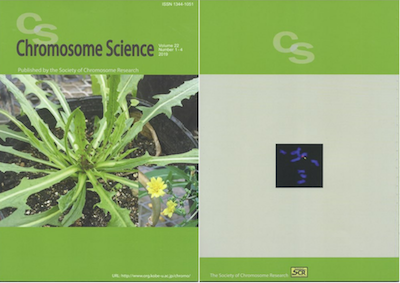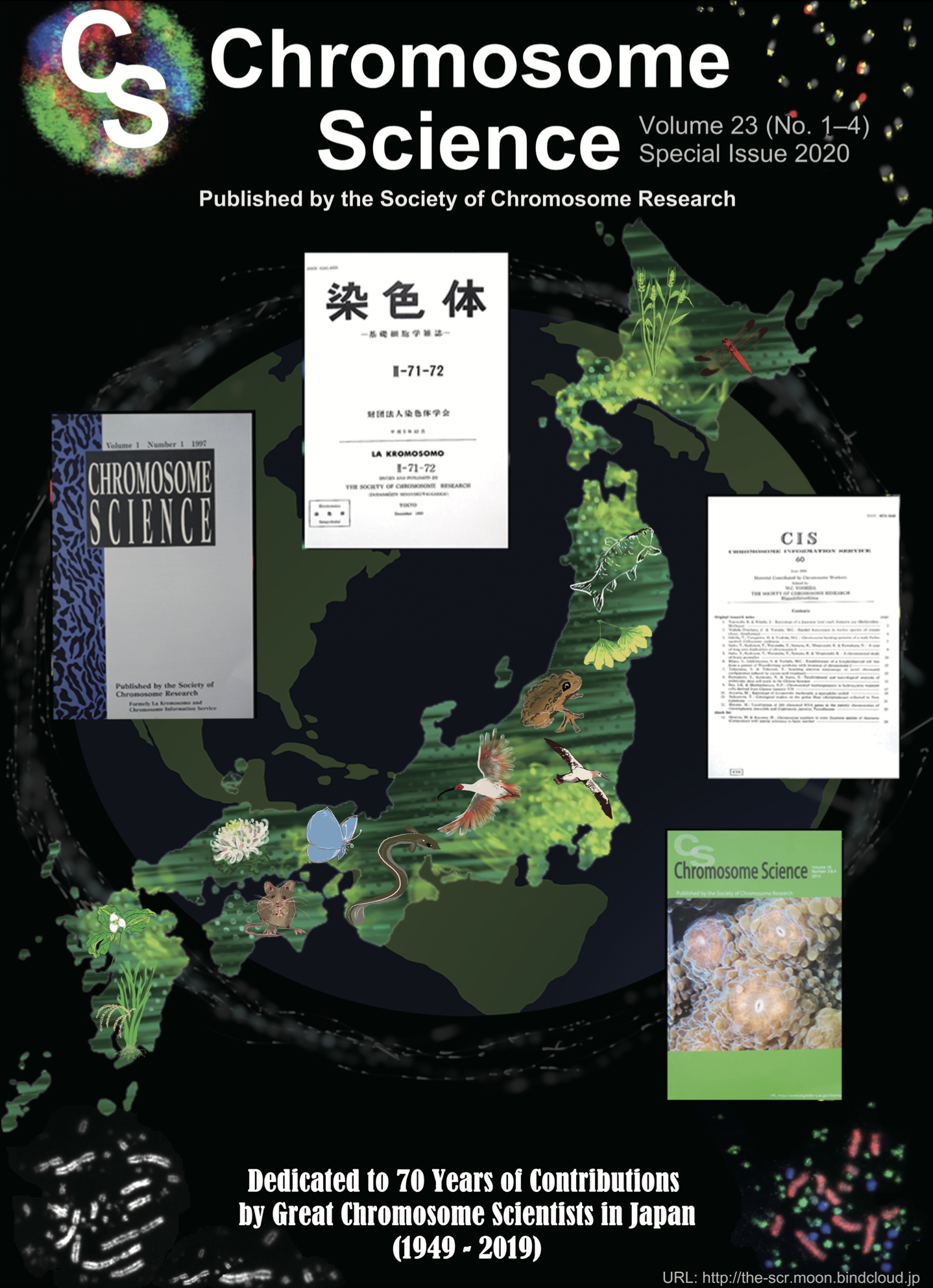-
News
The 74th Annual Meeting on the Web
We will open the 74th Annual Meeting of the SCR on the web at Oct. 21-22 2023.
Registration will starts in the beginning of Aug. within the web page.
-
Chromosome Science


Chromosome Science
Chromosome Science Vol.1~11 are here CiNii.
Instructions for Authors
Chromosome Science is the official journal of the Society of Chromosome Research (SCR), published in one volume of 4 issues, each year. SCR had published two journals, La Kromosomo and Chromosome Information Service since 1946 and 1960, respectively. These journals were united in 1996 and renamed Chromosome Science. Chromosome Science publishes original research reports in the fields of animal and plant cytogenetics, evolutionary aspects of chromosomes, gene mapping, cancer cytogenetics, comparative genetics, and genome studies. Abstracts of papers presented at the Annual Meetings of the SCR are also included. Methodological developments in areas such as differential staining of chromosomes, animal and plant cell culturing, cell fusion, gene and chromosome transfer, and in situ hybridization are also welcome.
Publication of Chromosome Science is open to non-members as well as the members of SCR.
Submission of Manuscripts
It is recommended to send a MS Word file (Text and Tables) and JPEG file (Figures) by e-mail to one of the following two addresses: For zoological and medical fields: tanabe_hideyuki@soken.ac.jp (Dr. Hideyuki Tanabe, Editor-in-Chief, School of Advanced Sciences, The Graduate University for Advanced Studies, Shonan Village, Hayama, Kanagawa 240-0193, Japan). For botanical and agricultural fields: wako@affrc.go.jp (Dr. Toshiyuki Wako, Editor-in-Chief, National Institute of Agrobiological Science, Japan). An e-mail receipt will be sent within a week from the Editor-in-Chief.
Form and Style
All manuscripts must be written in English, typewritten (point size, 12), and double-spaced on A4 (8.5" x 11") size paper with 2.5 cm (1") margins on all sides of the page. All pages should be numbered consecutively, including References, Tables, and Figure Legends. Manuscripts for Regular Articles should be organized in the following order: Title page, Abstract, Introduction, Materials and Methods, Results, Discussion, Acknowledgments (optional), References, Tables, and Figures.
Page 1 should contain the article title, names and addresses of all authors, and short running title, followed by telephone and fax numbers, and e-mail address, if any, of the corresponding author.
Page 2 should contain the abstract (approximately 200 words), in which a brief informative summary and the conclusions of the paper should be described. Avoid using references in the Abstract. In addition to the Abstract, 3 to 5 Keywords should be included for indexing purposes.
The text should start on page 3.
Article types
Regular Articles should be original reports not exceeding 7 printed pages (approximately 21 manuscript pages).
Short Communications should not exceed 5 manuscript pages, excluding title page. They should be preliminary data, technical notes or ongoing research that does not a warrant full-length article. Arrange in the following sequence: Title page, Abstract, Keywords, Text, References, Tables, and Figures. The maximum allowable number of figures and/or tables is three. References should be in the same style as for Regular Articles.
Reviews are normally commissioned by the editors. Authors should contact or send a short descriptive proposal before submitting a manuscript.
References
Citations in the text should be by author and year of publication. In case of 3 or more authors, only the first author's name followed by "et al." is needed. Reference list should be presented in alphabetical order by listing all authors. The names of journals should be abbreviated according to the Index Medicus. Examples are the following:
Journal article
Vaiman D, Pailhoux E, Payen E., Saidi-Mehtar N, Cotinot C (1995) Evolutionary conservation of a microsatellite in the Wilms tumor (WT) gene: mapping in sheep and cattle. Cytogenet Cell Genet 70:112-115
Book Chapter
Shaw P, Rawlins D, Highett M (1993) Nuclear and nucleolar structure in plants. In: Heslop-Harrison JS, Fravell RB (eds) The Chromosome. BIOS Scientific Publishers Ltd, Oxford, pp. 161-182
Book
Wagner RP, Maguire MP, Stallings RL. (1993) Chromosomes: A Synthesis. John Wiley & Sons, Inc., New York.
Tables and Figures
All Tables and Figures should be cited in the text. Each table should be printed on a separate sheet of paper and should include a title. Figures (photographs, drawings, diagrams, and charts) should be numbered consecutively with arabic numerals. Figures should be designed to fit into one (80 mm wide) or two (170 mm) columns, and not exceed the type area of 170 mm (width) x 225 mm (height) of a page. When two or more figures are mounted together, they should be arranged 1-2 mm apart. Each figure should have an accompanying legend, which should be typed double-spaced on a separate page.
Correspondence
For rapid publication, we wish to adopt e-mail as the main tool for correspondence between authors and the editor or editorial office. To avoid trouble with correspondence, please send an e-mail of acknowledgement soon after receipt of mail from the editor or editorial office. Page proofs will be sent to the corresponding author and should be checked carefully and returned within 2 days. Extensive alterations will be charged for.
Color Charge
Charge for publication in black & white is free. Color will be printed only at the author's expense (US$100 for each printed page). Reprints can be purchased at cost at the author's request and should be ordered when returning the proof.
Editrial board
Editors in Chief
Hideyuki Tanabe (Sokendai, Hayama, Kanagawa)
Toshiyuki Wako (National Institute of Agrobiological Science, Ibaraki)
Managing Editor
Souichirou Kubota (Toho Univ., Chiba)
Editors for Zoological and Medical fields
Sumire Inaga (Tottori Univ., Tottori)
Asato Kuroiwa (Hokkaido Univ.,Sapporo)
Takao Ono (RIKEN, Wako, Saitama)
Ken Sahara (Iwate Univ., Morioka)
Shinichi Sonta (Fetal Life Science Center, Nagoya)
Akinori Takai (Osaka Shin-Ai Coll., Osaka)
Nobuo Tsurusaki (Tottori Univ., Tottori)
Editors for Botanical and Agricultural fields
Kiichi Fukui (Osaka Univ., Osaka)
Shinji Kikuchi (Chiba Univ., Chiba)
Takato Koba (Chiba Univ., Chiba)
Yasuhiko Mukai (Osaka Kyoiku Univ., Osaka)
Minoru Murata (Okayama Univ., Okayama)
Kiyotaka Nagaki (Okayama Univ., Okayama)
Nobuko Ohmido (Kobe Univ., Hyogo)
Go Suzuki (Osaka Kyoiku Univ., Osaka)
Kenji Taniguchi (Hiroshima Univ., Hiroshima)
Maki Yamamoto (Kansai University of Welfare Sciences, Osaka)
Masatsugu Yokota (University of Ryukyus, Okinawa)
Committees
Chairman of the board
Hideyuki Tanabe (Sokendai, Hayama, Kanagawa)
Members of the board
Shinji Kikuchi (Chiba Univ., Chiba)
Souichirou Kubota (Toho Univ., Chiba)
Asato Kuroiwa (Hokkaido Univ.,Sapporo)
Kiyotaka Nagaki (Okayama Univ., Okayama)
Nobuko Ohmido (Kobe Univ., Hyogo)
Ken Sahara (Iwate Univ., Morioka)
Maki Yamamoto (Kansai University of Welfare Sciences, Osaka)
Honorary Board
Tetsuji Kadotani
Masawo Kamanoi
Midori Nishioka
Tohru Okigaki
Taro Shoji
Takuzo Yamada
Michihiro C. Yoshida
Tatsuro Ikeuchi
Secretary
Shinji Kikuchi (Chiba Univ., Chiba)
Administrative Aide
Sumire Inaga (Tottori Univ., Tottori)
Toshiyuki Wako (National Institute of Agrobiological Science, Ibaraki)
Business Office
Graduate School of Horticulture, Chiba University
Department of Plant Life Science
ATTN:
Secretariat of the Chromosome Society of Japan
648 Matsudo, Matsudo, Chiba 271-8510, Japan
TEL / FAX: To be determined
E-mail: skikuchi@faculty.chiba-u.jp
(Office hours: Monday, 10:00 a.m. - 3:00 p.m.)
How to join the JSCR
Membership Application Procedure and Annual Membership Fee
(1) If you wish to become a member, please fill out the application form Admission Application Form JSCR_(2021JE).pdf, Admission Application Form JSCR_(2021JE).doc) and send it to our office by e-mail, fax or mail.
(2) Please pay the membership fee to the following account.
Bank transfer (Payee)
Postal transfer
Account number: 01390 - 3 - 23060
Subscriber name: Secretariat of the Chromosome Society of Japan Senshokutai Gakkai Gimukyoku
Annual membership fee (JPY)
Director/Auditor: 12,000 yen
Councilor: 10,000 yen
General member: 8,500 yen
Student member A: 6,000 yen (Include distribution of Chromosome Science)
Student member B: 1,000 yen (without Chromosome Science )
*In the cases of research student or trainee, you can become a general member if you have income, or Student member A or Student member B if you are have no income. Please confirm the relevant amount and transfer the money.
(3) After confirming that the annual membership fee has been transferred, you will be notified by e-mail that the admission procedure has been completed.
*If you are a student member, we will send an e-mail to you and your faculty advisor to inform you of the completion of the admission procedure.





















